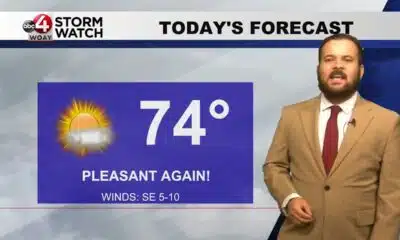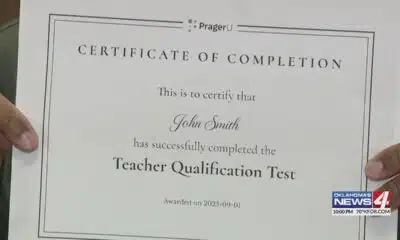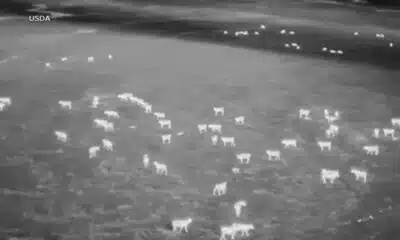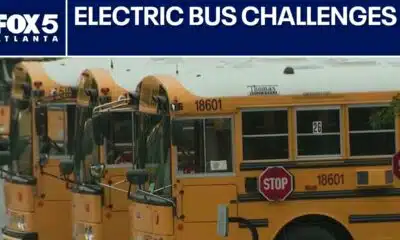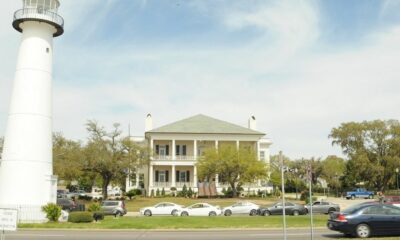News from the South - Arkansas News Feed
Supply kits help support new postpartum moms
SUMMARY: Arkansas faces a high maternal mortality rate, prompting efforts to improve outcomes for new moms. The U.S. Hospital in Little Rock is addressing this by distributing postpartum supply kits to new mothers. The kits, which include essential items often missing from registries, aim to support moms with tools and education on maternal and infant health. A three-tier approach includes standardized education, an “I gave birth” bracelet for emergencies, and a proactive call center to check on new moms. The program, launched last month, plans to expand statewide by summer to all 33 hospitals and delivery units.
UAMS in Little Rock has started distributing mother and infant supply kits to new moms to help improve maternal healthcare for Arkansans.
News from the South - Arkansas News Feed
Arkansas Fall forecast: Warmer temperatures and drier conditions expected as drought persists
SUMMARY: Arkansas is expected to experience a cooler and more fall-like September, starting meteorological fall on September 1st. The last week of August was among the coolest on record, and early September will continue with below-average temperatures. A cold front later next week will bring further cooling, making the second weekend of football season comfortable. Mid-September temperatures will remain fairly mild, with highs dropping from mid-80s to mid-70s in Northwest Arkansas and from low 90s to low 80s in the River Valley by month’s end. Fall colors should appear earlier than last year, likely peaking from late October to early November.
The Climate Prediction Center released its outlook for Fall, which shows above-average temperatures continuing through November.
Subscribe to 40/29 on YouTube now for more: http://bit.ly/PTElbK
Get more Northwest Arkansas news: http://www.4029tv.com
Like us: http://facebook.com/4029news
Follow us: http://twitter.com/4029news
Instagram: https://www.instagram.com/4029news/
News from the South - Arkansas News Feed
Sylvan Hills defeats Maumelle in Zero Week thriller
SUMMARY: Sylvan Hills ended a 20-game losing streak by defeating Maumelle 55-54 in a thrilling zero-week high school football game. Despite trailing at times, the Bears showcased resilience with key plays from Bubba Johnson and Tyler Hampton, tying the game 28-28 at halftime. Maumelle’s Levi Warrior made impressive catches, keeping the Hornets competitive. In the closing seconds, Maumelle nearly secured the win, but a controversial goal-line stop gave Sylvan Hills the victory. This dramatic opener signals an exciting 2025 season ahead, marking Sylvan Hills’ first win in two years and an intense start for both teams.
Sylvan Hills breaks a 20 game losing streak with a 55-54 win over.
News from the South - Arkansas News Feed
Judge orders Central Arkansas district to remove Ten Commandments displays
by Antoinette Grajeda, Arkansas Advocate
August 28, 2025
A federal judge Thursday evening ordered the Conway School District to remove Ten Commandments posters from classrooms and libraries, less than 24 hours after the district was added to a lawsuit challenging a state law requiring the displays.
Act 573 of 2025 requires public schools to “prominently display” a 16”x20” poster or framed copy of a “historical representation” of the Ten Commandments. U.S. District Judge Timothy Brooks issued a preliminary injunction earlier this month that blocked enforcement of the law at four Northwest Arkansas school districts — Bentonville, Fayetteville, Springdale and Siloam Springs.
Seven multifaith families who filed the lawsuit against the four districts in June allege the new law violates the First Amendment’s Establishment Clause, which guarantees that “Congress shall make no law respecting an establishment of religion,” and its Free Exercise Clause, which guarantees that “Congress shall make no law … prohibiting the free exercise [of religion].”
Supporters of the law argue the Ten Commandments are a historical document because they influenced the nation’s founders and their creation of the country’s legal system.
Central Arkansas school district added to Ten Commandments suit
Brooks granted a request from plaintiffs’ attorneys Wednesday to add the Conway School District as a defendant to the case and families from the district who allege they’ve been injured by the district hanging Ten Commandments displays in their children’s schools.
Plaintiffs’ attorneys filed a supplemental complaint adding the new parties to the case Thursday and filed a motion for a temporary restraining order on behalf of two Conway School District families. Brooks granted the temporary restraining order later on Thursday and held the request for a preliminary injunction in abeyance.
“Conway Plaintiffs are identically situated to the original Plaintiffs: They advance the same legal arguments, assert the same constitutional injuries, and request the same relief,” Brooks wrote.
School districts named in the lawsuit and Arkansas attorney general’s office, who intervened in the case, may submit briefs no later than Sept. 8 to address why the current preliminary injunction should not be modified to include the Conway School District, according to the order.
Brooks also temporarily enjoined the Conway School District from enforcing the law and directed the district to remove all the Ten Commandments posters by 5 p.m. Friday.
“Conway School District had every opportunity to do the right thing and respect families’ constitutional rights, but instead chose to defy a clear federal ruling,” ACLU of Arkansas Legal Director John Williams said in a statement. “The court has now made it crystal clear: forcing the Ten Commandments into public school classrooms is unconstitutional. We stand ready to defend the rights of every Arkansan against this kind of government overreach.”
The ACLU of Arkansas is representing the plaintiffs along with the national American Civil Liberties Union, Americans United for Separation of Church and State, and the Freedom From Religion Foundation. Simpson Thacher & Bartlett is serving as pro bono counsel.
“I am disappointed in the ruling but will continue to vigorously defend Act 573,” Attorney General Tim Griffin said in a statement.
Support our third anniversary fundraiser with a donation today.
Arkansas Advocate is part of States Newsroom, a nonprofit news network supported by grants and a coalition of donors as a 501c(3) public charity. Arkansas Advocate maintains editorial independence. Contact Editor Sonny Albarado for questions: info@arkansasadvocate.com.
The post Judge orders Central Arkansas district to remove Ten Commandments displays appeared first on arkansasadvocate.com
Note: The following A.I. based commentary is not part of the original article, reproduced above, but is offered in the hopes that it will promote greater media literacy and critical thinking, by making any potential bias more visible to the reader –Staff Editor.
Political Bias Rating: Center-Left
The content presents a legal challenge to a state law requiring the display of the Ten Commandments in public school classrooms, emphasizing constitutional concerns and the involvement of civil liberties organizations like the ACLU. While it includes perspectives from supporters of the law, the overall tone and focus on constitutional rights and government overreach align more closely with a center-left viewpoint that prioritizes separation of church and state and individual rights.
-
Mississippi Today2 days ago
DEI, campus culture wars spark early battle between likely GOP rivals for governor in Mississippi
-
Mississippi Today6 days ago
Judge: Felony disenfranchisement a factor in ruling on Mississippi Supreme Court districts
-
News from the South - Louisiana News Feed5 days ago
K+20: Katrina alters local health care landscape, though underlying ills still the same
-
News from the South - North Carolina News Feed5 days ago
Parasocial party: Why people are excited for the Taylor Swift, Travis Kelce engagement
-
Our Mississippi Home7 days ago
Katrina Remembered: A Hattiesburg Perspective
-
Mississippi News Video7 days ago
Today’s First Alert Weather Kid is Karson (8/26)
-
Local News7 days ago
Parents of missing 7-month-old California boy are charged with murder
-
Our Mississippi Home6 days ago
The Great Backyard Recovery – Helping Birds After the Storm





